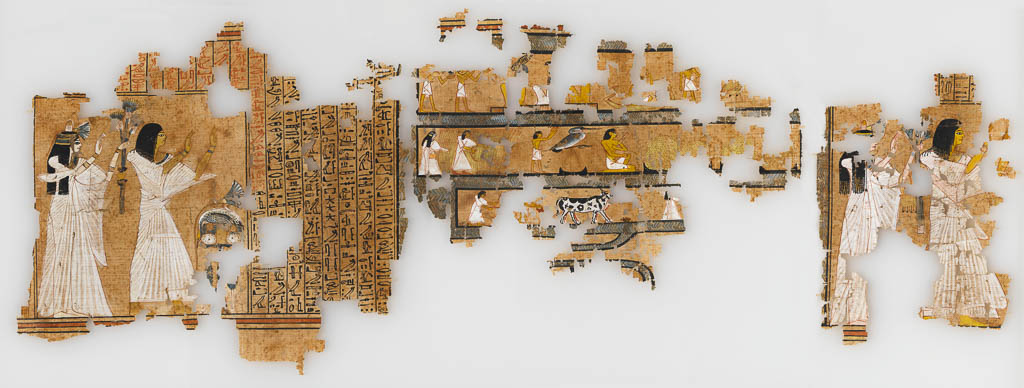Look and Think activities should take 5 -10 minutes.
Do activities might take longer depending on the task and how creative you are feeling!
(Parts of the) Book of the Dead, made for a man called Ramose
Unknown maker, Egypt, 1300 BCE, Papyrus
20 m long and 41 cm high, E.2.1922
Look
The artist or artists that made this were incredibly skilled at capturing the natural world around them.
What animals can you spot? Which is your favourite? Look closely here.
Think
What would you include in the book of the dead to help you in the afterlife?
What advice would you give to someone else that you find helpful?
Do
Make your own papyrus following our easy step by step video.
When it is finished you can try decorating it using an ancient Egyptian style paint brush that you can make following this video.

For the papyrus, you will need:
- Two sheets of tin foil
- One cup of flour and two cups of water – and a bowl to mix them in ( or watered down PVA glue)
- Paper to rip into strips ( we used old envelops and brown bags to match the papyrus colour)
- A rolling pin or something heavy to help flatten
1. Lay a sheet of tin foil on your surface
2. Mix your glue in a bowl – two parts water to one part flour (or use watered down PVA glue)
3. Rip your paper into strips
4. Dip your strips into the glue one at a time removing the excess liquid with fingers
5. Lay your strips in one direction overlapping each other
6. Now lay a second layer in the other direction
7. Cover with your second sheet of tin foil and roll or bash flat
8. Leave it to dry, checking it is not sticking to the foil
9. Decorate your Papyrus using instructions on how to make an Ancient Egyptian paintbrush here
The Book of the Dead was a collection of spells and instructions placed in the tomb or coffin to ensure the dead person’s safe passage through the after-life. First written on linen mummy shrouds and later on rolls of papyrus, Books of the Dead are found in Egyptian burials from around 1650 BC.
The owner of this particular papyrus is called Ramose, a high official who lived in the 13th century BC. His name and job title ( supervisor of royal archives) is written in all the spells to make sure that they work specifically for him. From the writing and the style of clothing shown in the illustrations on the papyrus, as well as from his burial it was found in, we can tell that he lived around 1300 BCE.
Since it arrived at the Fitzwilliam Museum in 1922, the papyrus containing the Book of the Dead written for the supervisor of royal archives, Ramose, has remained in storage, with the exception of two sections that were displayed for about 40 years. As a result, the beautiful colours of the pictures (known as vignettes) which illustrate the papyrus and the borders have remained in unusually good condition. Making this object one of the finest examples of funerary literature to have survived from ancient Egypt.
When it was originally discovered in 1922 in a tomb at Sedment in Egypt by the important archaeologist Sir William Flinders Petrie, the Book of the Dead of Ramose was in hundreds of pieces. However, conservators painstakingly were able to reconstruct a great deal of the original layout piece by piece. The document itself is made from individual sheets of papyrus which have been stuck together to form a large roll, which we can estimate to have been more than 20 metres in length and 41 cm in height, which is rather larger than other versions have been.
The book is made from papyrus. Papyrus is a plant, rather like a reed, which used to grow in Egypt. In ancient times, the Egyptians used it to make small, light-weight boats, sandals, mats and baskets, as well as a paper-like material seen here for writing on. Although they are made from a plant, the very dry climate of Egypt has meant that many examples of papyrus have survived from the past. The oldest example of a roll of papyrus (without writing) is around 5000 years old.
You can learn more about this object and how it was conserved in this online exhibition.
Download this Look Think Do as a PDF or Word document.